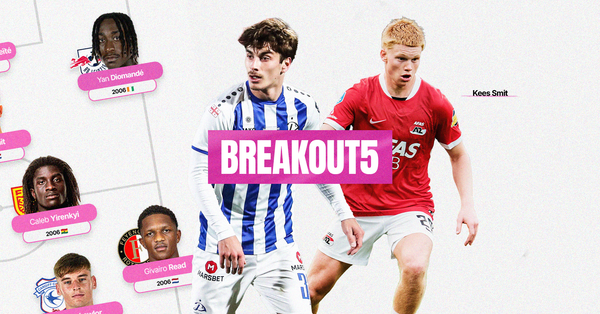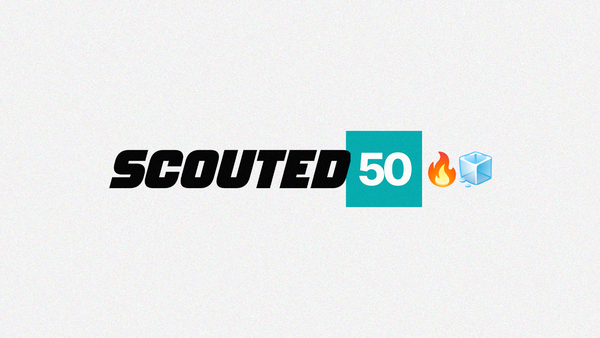Finding the right massive number nine: a big German case study
Separating style from size using a spawn of Big German Forwards
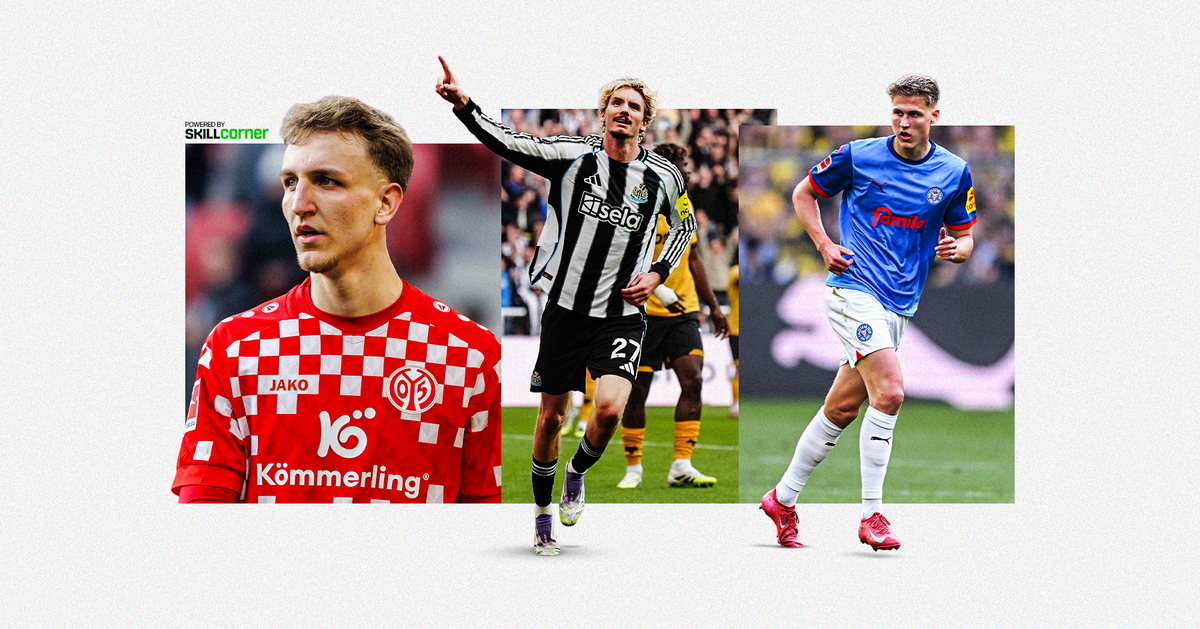
All the strikers are massive now. But that does not mean they have to play the same way.
I spent the summer in awe of the size of German forwards. The 1.98m Nick Woltemade and 1.91m Nelson Weiper finished the U-21 EURO as Germany’s first-choice strike-pairing. Meanwhile, Max Moerstedt led the German frontline at the U-19 EURO. In fact, it was watching the 1.94m wunderkind throw his long limbs at crosses against Norway that crystallised the idea for this article in my mind: Germany are spawning 1.9m strikers.
That is a good thing. As Ashwin Raman recently discussed in a SCOUTED column, an imposing stature has become a must-have trait for strikers at the elite level. However, size does not dictate style. There are multiple ways you can “give it to the big man and let him dominate” and in the era of massive number nines it’s important to find the right one. Even if all the strikers are massive, the value of Archetypes and player profiling is still important.
The Big German Forwards
We’re going to prove it using SkillCorner data. But first, we need to confirm our pool of BGFs. Unfortunately, Moerstedt did not meet the minimum minutes threshold for the 2024/25 season; we will have to evaluate his output next summer. Instead, I have called upon three others to illustrate the multiple ways you can measure a 1.9m striker.
Kai Havertz is arguably Germany’s first-choice forward and stands at 1.93m tall, he even appears to have hulked out over the summer. In a handful of 2024/25 Nations League games, Havertz played behind 1.94m Tim Kleindienst. The final BGF we are going to profile is Phil Harres.
Harres has a fascinating origin story. In 2023/24, he was playing in the fourth tier of German football for FC 08 Homburg. He scored 24 goals in 34 league games, earning a move to Bundesliga debutants Holstein Kiel for the 2024/25 campaign. Despite being relegated, the 1.93m striker scored eight goals in 1,500 minutes. Not bad for his taste of professional football above the fourth tier.
By evaluating the data profiles of these five BGFs during the 2024/25 season, it should become clear that although the best strikers now come in big packages, what’s inside can be very different.
How do Big (German) Forwards move?
When developing Centre Forward Archetypes with SkillCorner Data, Off-ball Running has been at the core. This is because Centre Forwards make more Runs per Match on average than any other Position Group. Archetypes are not just developed based on the traditional blends of these Runs, but also the idiosyncratic combinations and even the extremes.
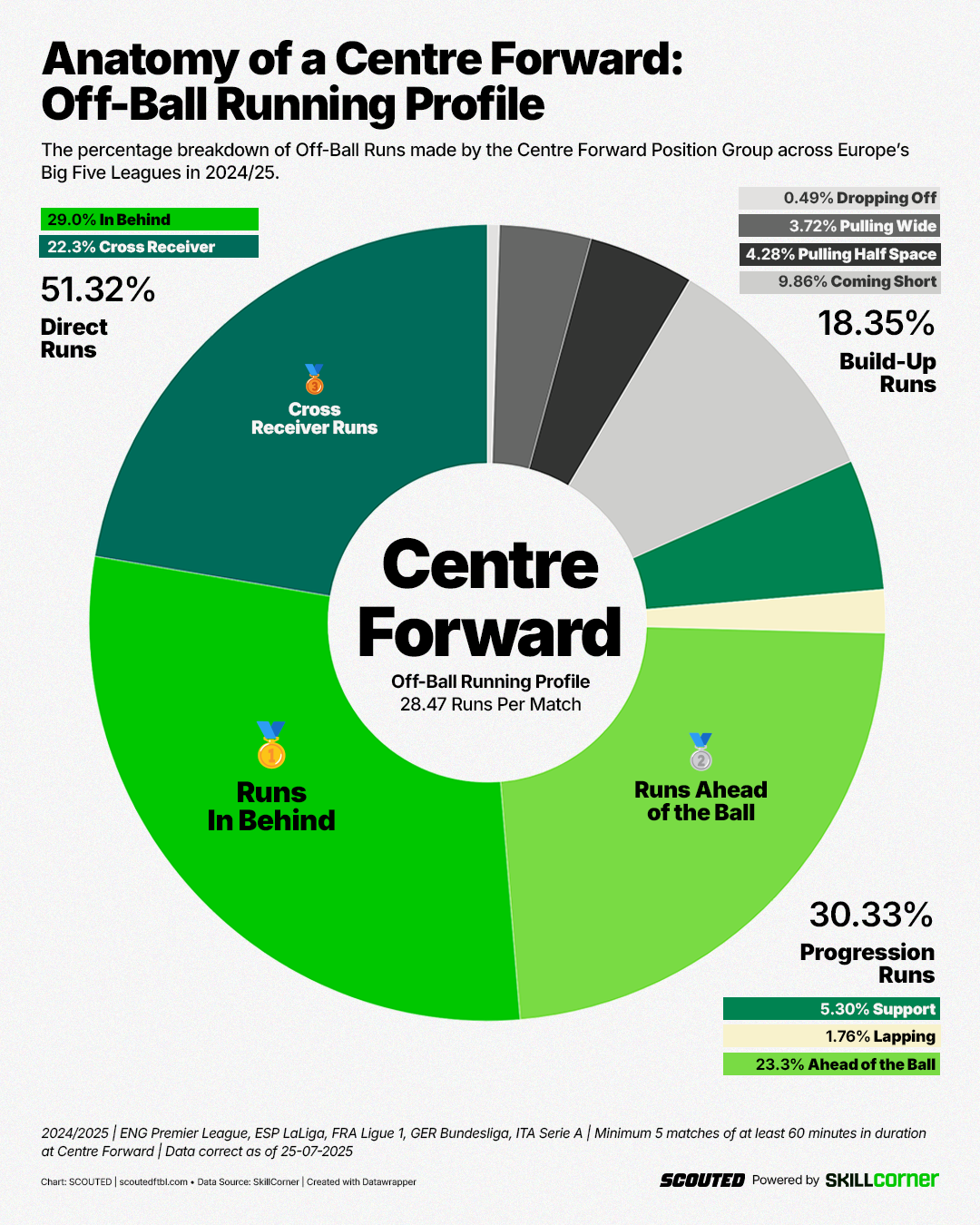
The Power Forward is an example of an extreme Archetype. This profile centres on the relationship between high-speed Sprints and Runs In Behind. And there should be lots of them. So, let’s first take a look at the Sprint output.

Harres is the BGF leader for all-but-one metric and emerges as the leading candidate for this profile. Woltemade is ranked last for six out of seven, ruling him out completely. Already we have a huge contrast between two of our massive strikers.
The next step is to look at the Off-ball Running profiles, at first focussing on those three main Centre Forward Run Types: Runs In Behind, Runs Ahead of the Ball, and Cross Receiver Runs.
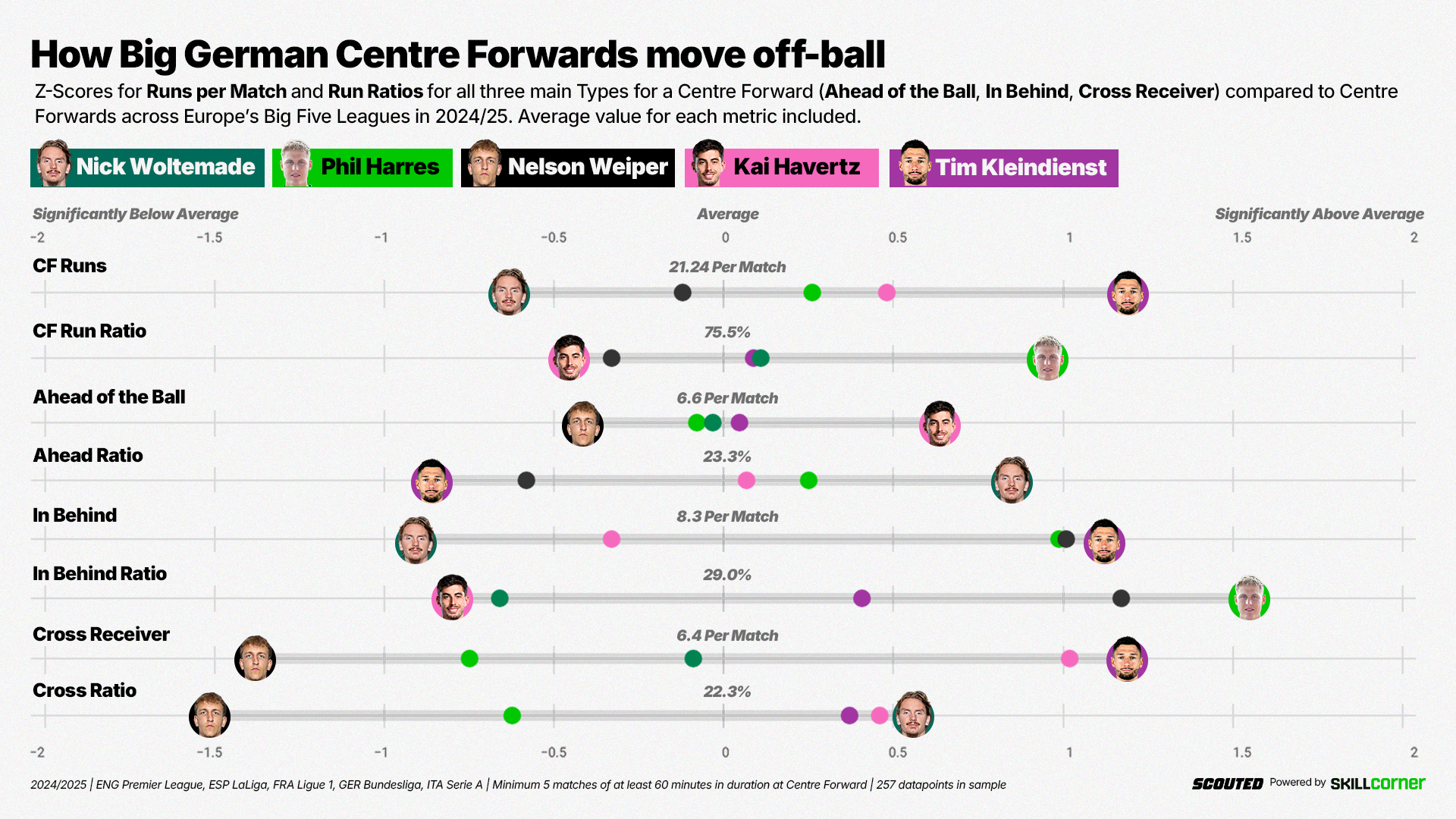
Dialling in on the Runs In Behind Run Ratio in search of our Power Forward, both Weiper and Harres stand out. Although this figure stands at 38.9% for Weiper, he did not have the Physical profile to match the Power Forward Archetype criteria.
For Harres, however, Runs In Behind make up an even greater proportion of his run profile. His 42.8% ratio ranks him 15th for that metric in our dataset. This combined with his Sprint output confirms Harres’ place as the BGF Power Forward and shows that height is no barrier to the battering-ram approach of a Power Forward.
If your club was looking for a massive number nine that uses their jumbo frame to add verticality, Harres would be a much better pick than Woltemade.
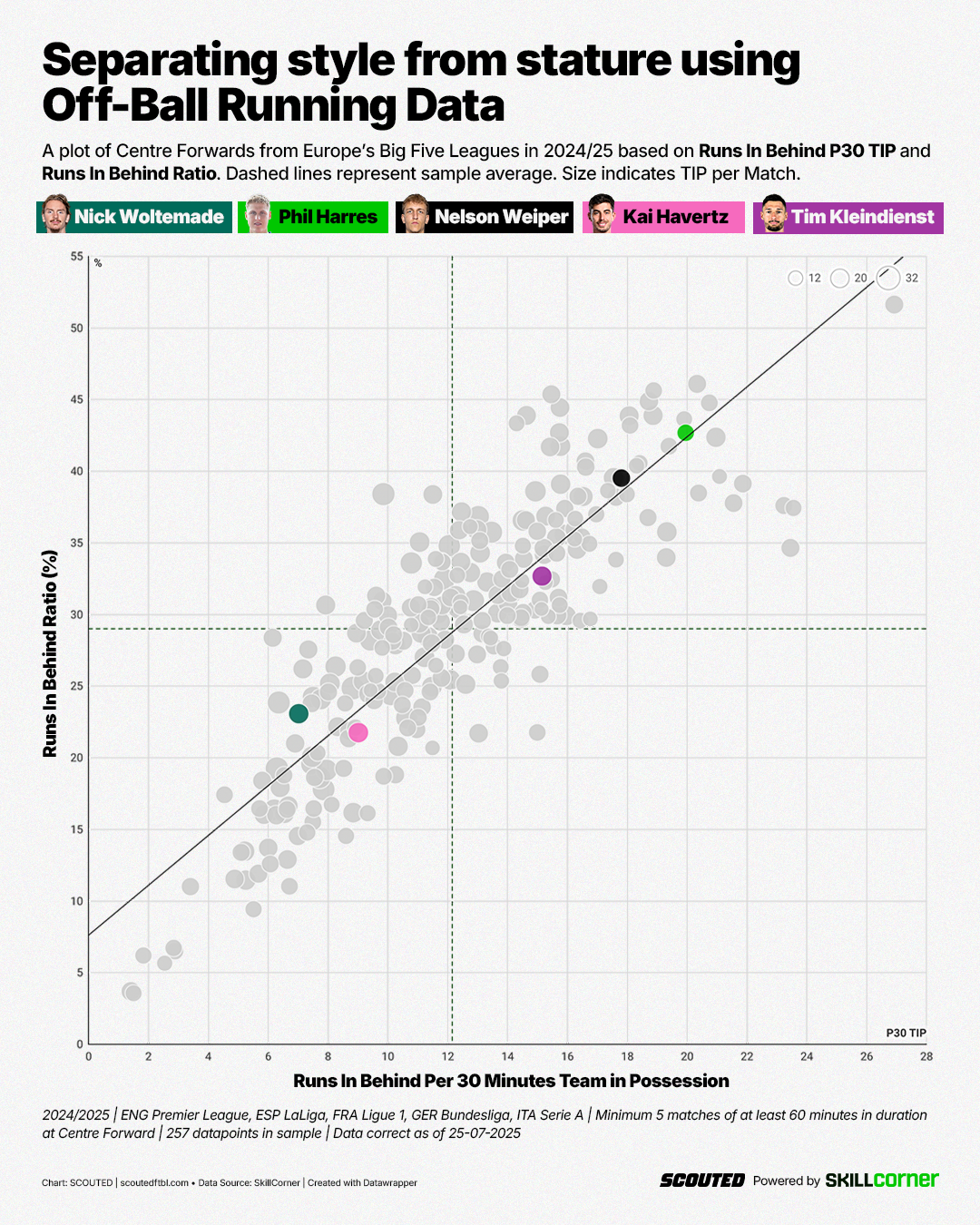
Next, we will look at Cross Receiver Runs. Did you notice that both Havertz and Kleindienst moved towards significantly above average for the number of Cross Receiver Runs yet their Ratio of these Runs was closer to the middle line? This means that they are not characterised by this Run Type. The fact that Kleindienst also makes an above-average number of Runs In Behind introduces another Archetype: the Point Forward.
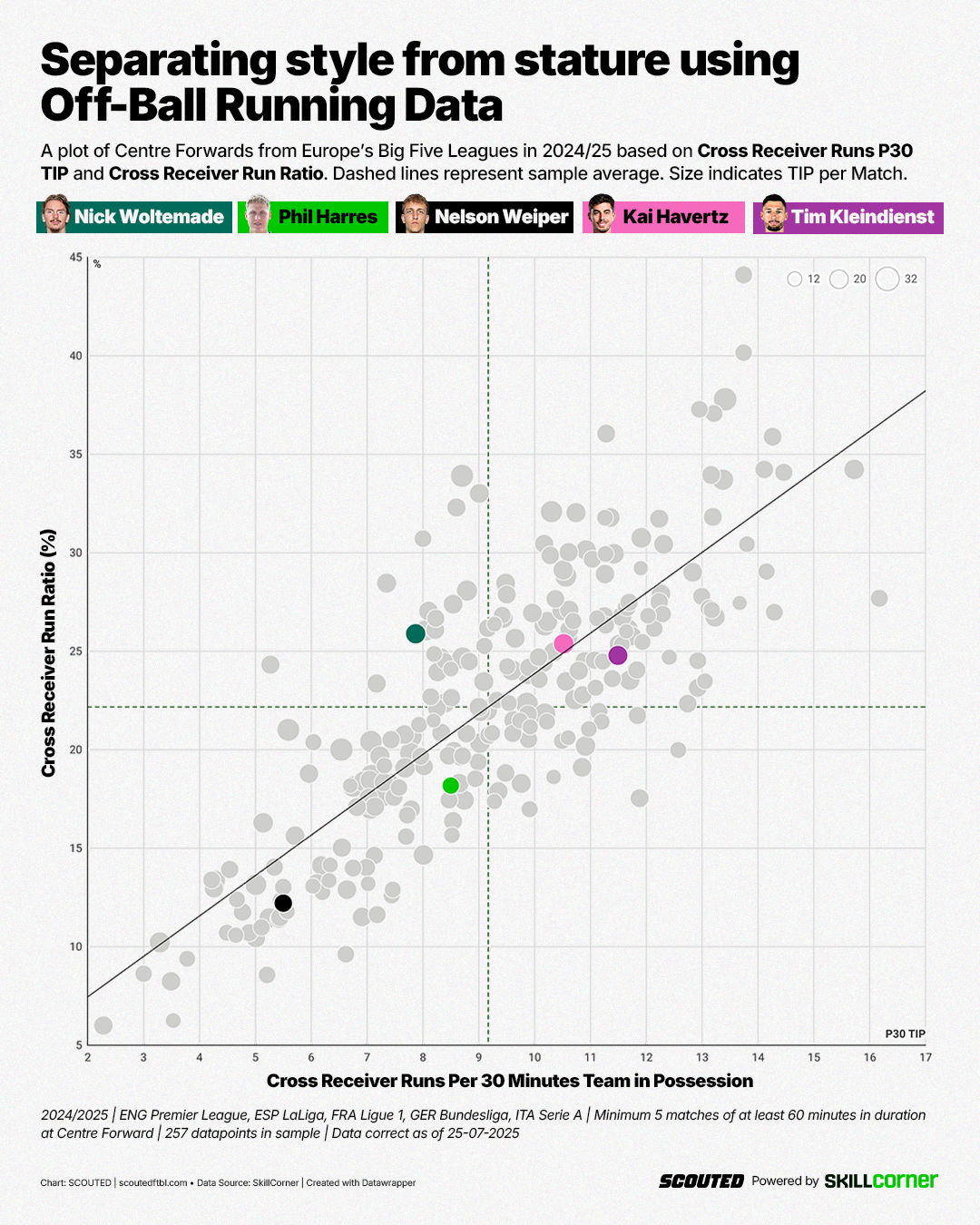
This profile is most similar to the classic number nine. A Point Forward is a Centre Forward that is most often seen dropping to link before spinning in behind. They can also work across the frontline and become a reliable target in the penalty area. If a Power Forward adds verticality, a Combo Forward operates laterally, and a Goal Hanger is a relatively static box presence, then a Point Forward is a mixture of all three. That’s why an emphasis is placed on the combination of Runs In Behind and Cross Receiver Runs, which SkillCorner refers to as Direct Runs.
By plotting Runs In Behind and Cross Rece
iver Runs with the Direct Run Ratio for context, we can quickly sort an entire dataset into Archetypes. Only Harres and Weiper share the same quadrant. The rest of our BGFs are split.
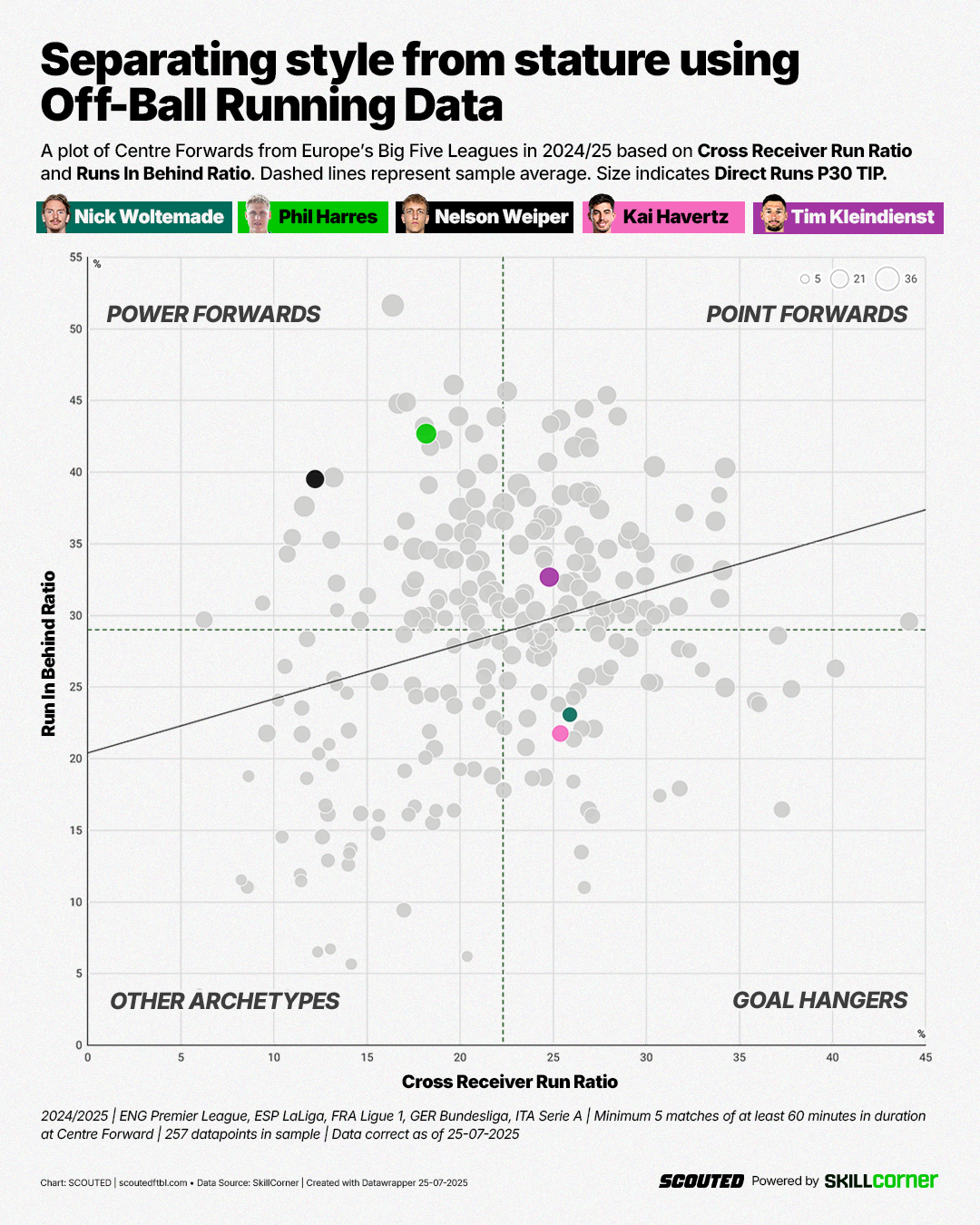
Interestingly, if we look at the ratios of those Direct Run Types, Woltemade moves into the Goal Hanger bracket alongside Kai Havertz, who remains in a similar position - as do the other BGFs. If you were looking for a massive number nine that uses their jumbo frame to stretch the opposition and provide a box presence, Kleindienst is the optimal stylistic pick.
At the moment, our biggest BGF is the biggest mystery.
Woltemade is the only one with Runs Ahead of the Ball as his primary Run Type. But, he still makes the fewest of them when compared to our BGFs, as he does for Centre Forward Runs in total.
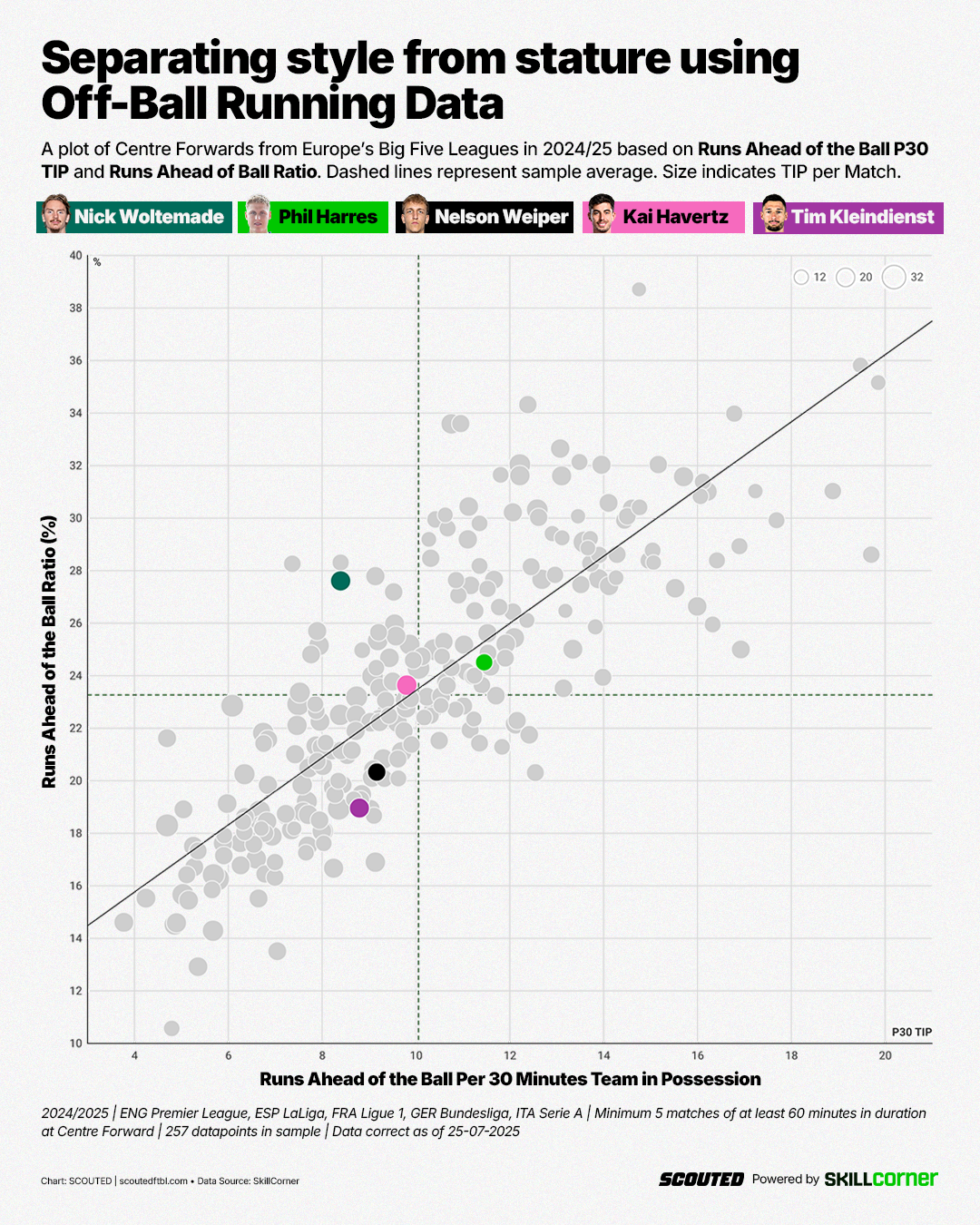
Let’s investigate the other Types to learn more.
Dropping Off and Lapping Runs represent less than 2% of the average Run profile so have been excluded. However, Havertz’s substance and style Z-Scores for Pulling Wide and Lapping Runs were two of the highest.
This could highlight his lack of ‘out-and-out centre-forward’ instincts and his non-orthodox reprisal of the role. But it could also be a reflection of Arsenal’s horseshoe approach to low blocks, forcing them to create space in those wider channels. I think it’s a bit of both. However, as these Types make up the smallest proportion of the average Centre Forward Running profile, we should be careful with how much value we place on them.
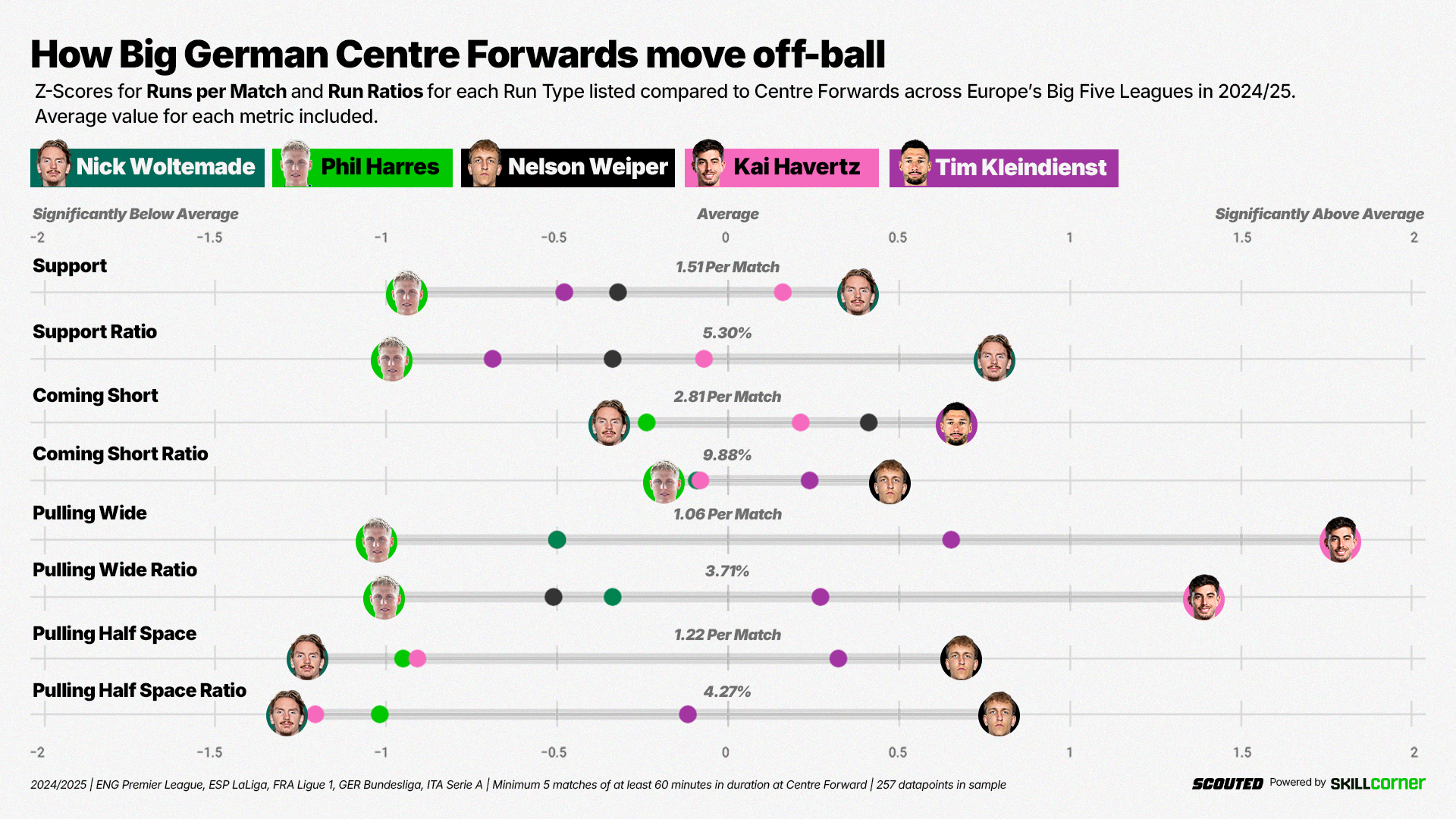
Woltemade was an outlier for Coming Short and Support Runs at the U-21 EURO this summer but a greater sample size has seen these figures drop closer towards the average. That said, Woltemade is the only BGF that ranks above it for both Support Runs P30 TIP and Support Run Ratio.
Even then, considering his below average Physical output in conjunction with no meaningful deviation above the Off-ball Running averages, it has become clear that not every Archetype can or should be defined solely by the Off-ball Running profile and he is clearly using his jump frame to achieve another goal. To show that not all Big German Forwards are built the same, we need to move onto the next suite of Game Intelligence Data.
How do Big (German) Forwards deal with Pressure?
In the past, you might expect all 1.9m strikers to behave in a similar way under Pressure. Our BFGs do not.
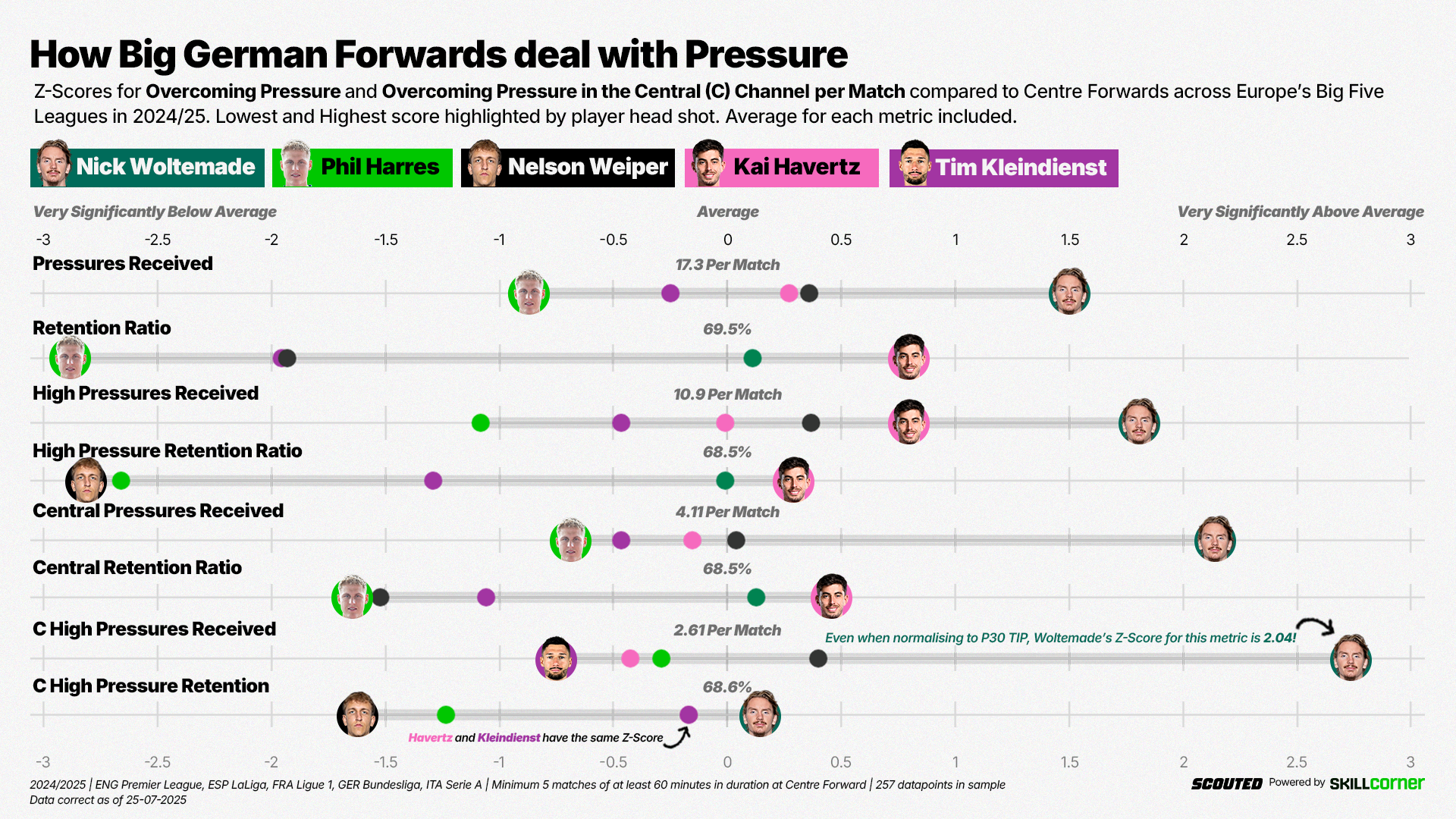
The scale for the Pressure Z-Scores is larger than for Off-ball Running due to the more extreme contrasts between our BGFs. The most stark of which is between our In Behind runners - Harres and Weiper - and Woltemade.
To hammer home the differences we’re starting to see: if we normalise P30 TIP, Harres receives nearly half as many High Pressures as Woltemade (12.8 vs. 22.31) but makes nearly three times as many Runs In Behind (20.24 vs. 7.44). That is two degrees of gaping separation between stature and style.
Woltemade’s superpower is attracting, absorbing and overcoming pressure. He retains the ball under High Pressure with much greater success than the other U-23 BGFs in particular: Weiper is ranked last for Ball Retention under High Pressure and Harres is third from bottom. Havertz, meanwhile, deals with it better than his occasional partner Kleindienst. Just as a jumbo frame did not guarantee elite speed, it does not guarantee elite hold-up play.
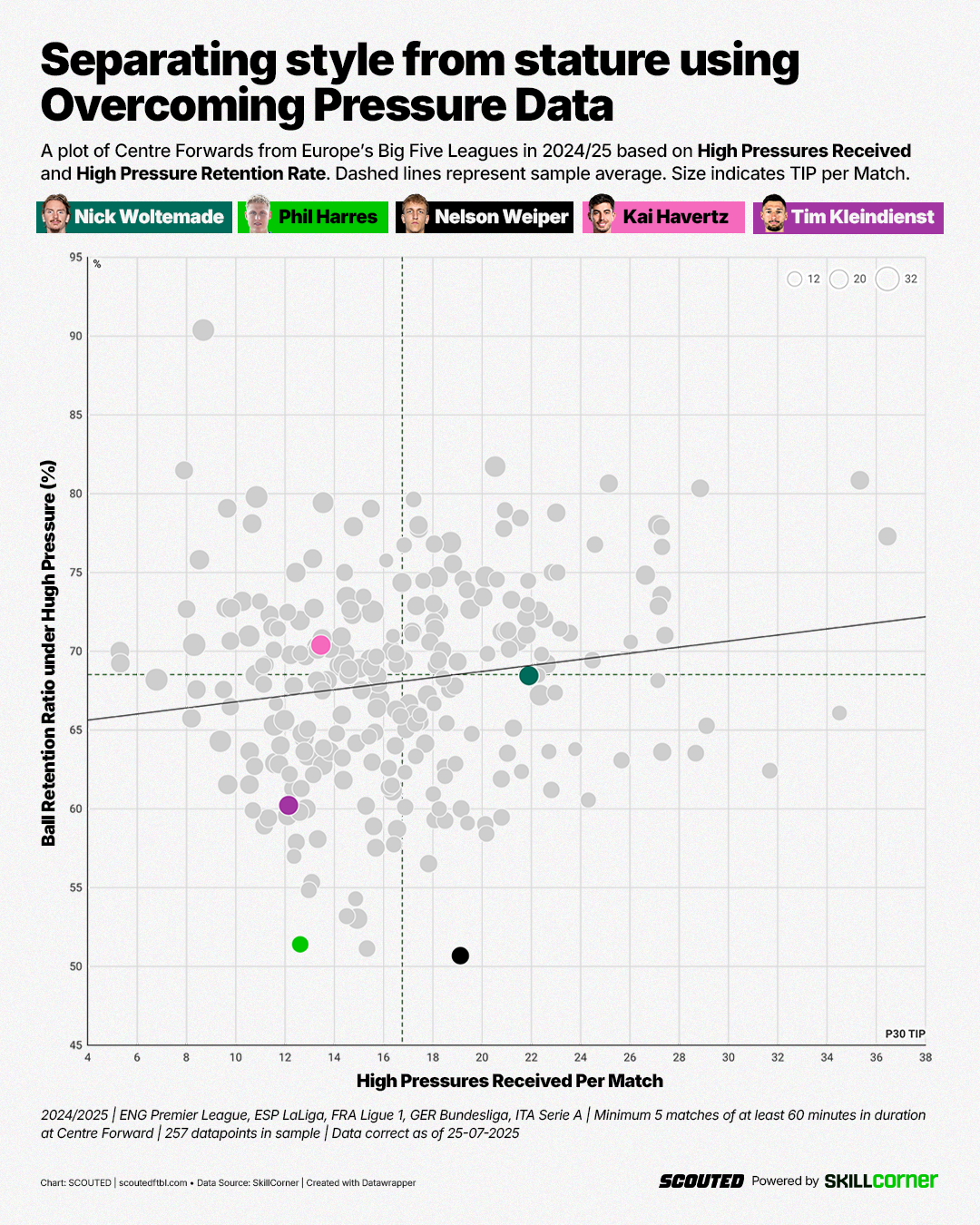
SkillCorner Data also allows us to investigate specific areas of the pitch. As seen through the Pressure Z-Scores, focussing purely on the Central Channel - the width of the six-yard box - created clear separation between Woltemade and the rest of the BGFs.
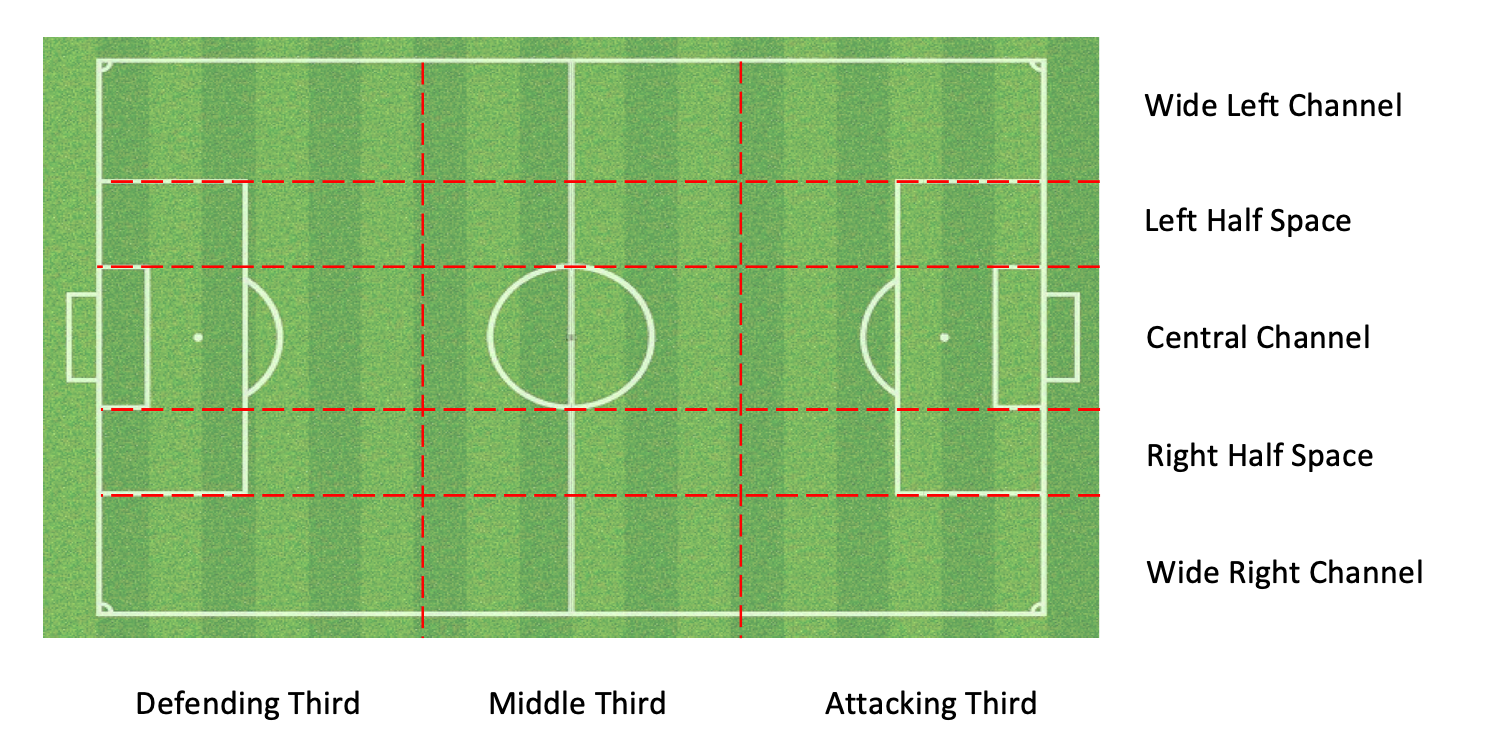
He ranks in the top five for High Pressures Received per Match and stacks up well Per 30 TIP (as seen below). He also maintains a slightly-above average Retention Rate despite the outlying volume of Pressures Received. In the context of the BGFs, he’s in his own world.
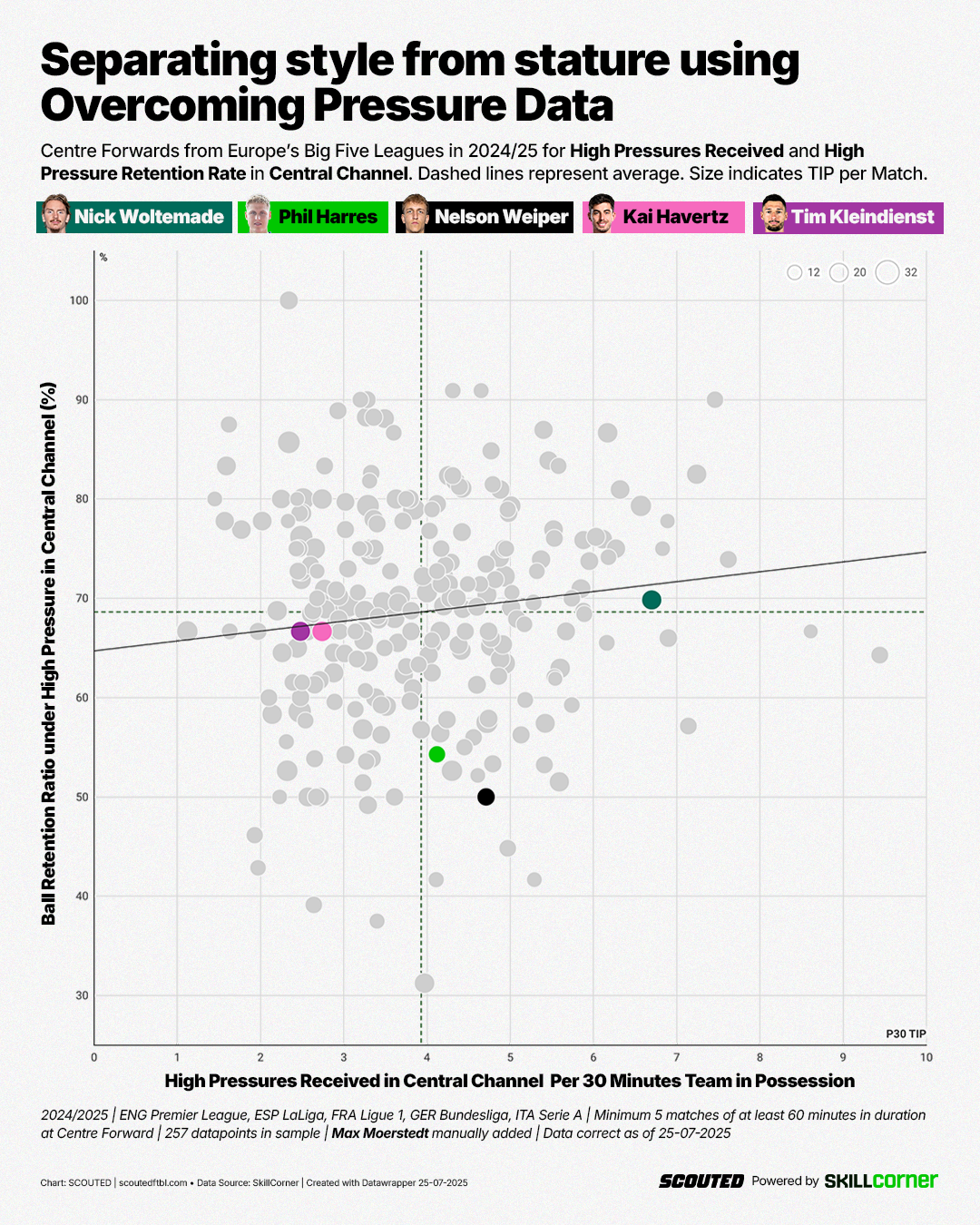
Woltemade would likely be the only BGF to appear for a club searching for a massive number nine to use their jumbo frame to overcome pressure in order to create space for and combine with teammates.
Harres’ power running and Woltemade’s gravity have emerged as two unique traits among our Big German Forwards. The final way to separate them is through their Passing.
How do Big (German) Forwards pass the ball?
We can stick with Overcoming Pressure Data initially to highlight the different Passing behaviour.
When plotting the two metrics together, the likes of Alexander Isak, Kylian Mbappé and Omar Marmoush appear in close proximity to Woltemade. Perhaps this ability to find teammates under duress is a key area Newcastle identified when looking to replace the Swede. Or at the very least, a part of his game they wanted to ensure was not lost.
Even so, if judging books by their cover, it’s unlikely you would have said those Centre Forwards are similar. Once again, this shows that size does not dictate style. We also create a spectrum for our BGFs, with the contrast between the facilitating nature of Woltemade’s profile and the direct style of Harres the most stark once again.
Woltemade is the only BGF with an above average output for Pass Attempts under High Pressure P30 TIP. If we look at Dangerous Passes under High Pressure, Woltemade again pulls clear of the group: he is one of just 21 players in this dataset with 2+ Dangerous Passes Completed under High Pressure P30TIP.
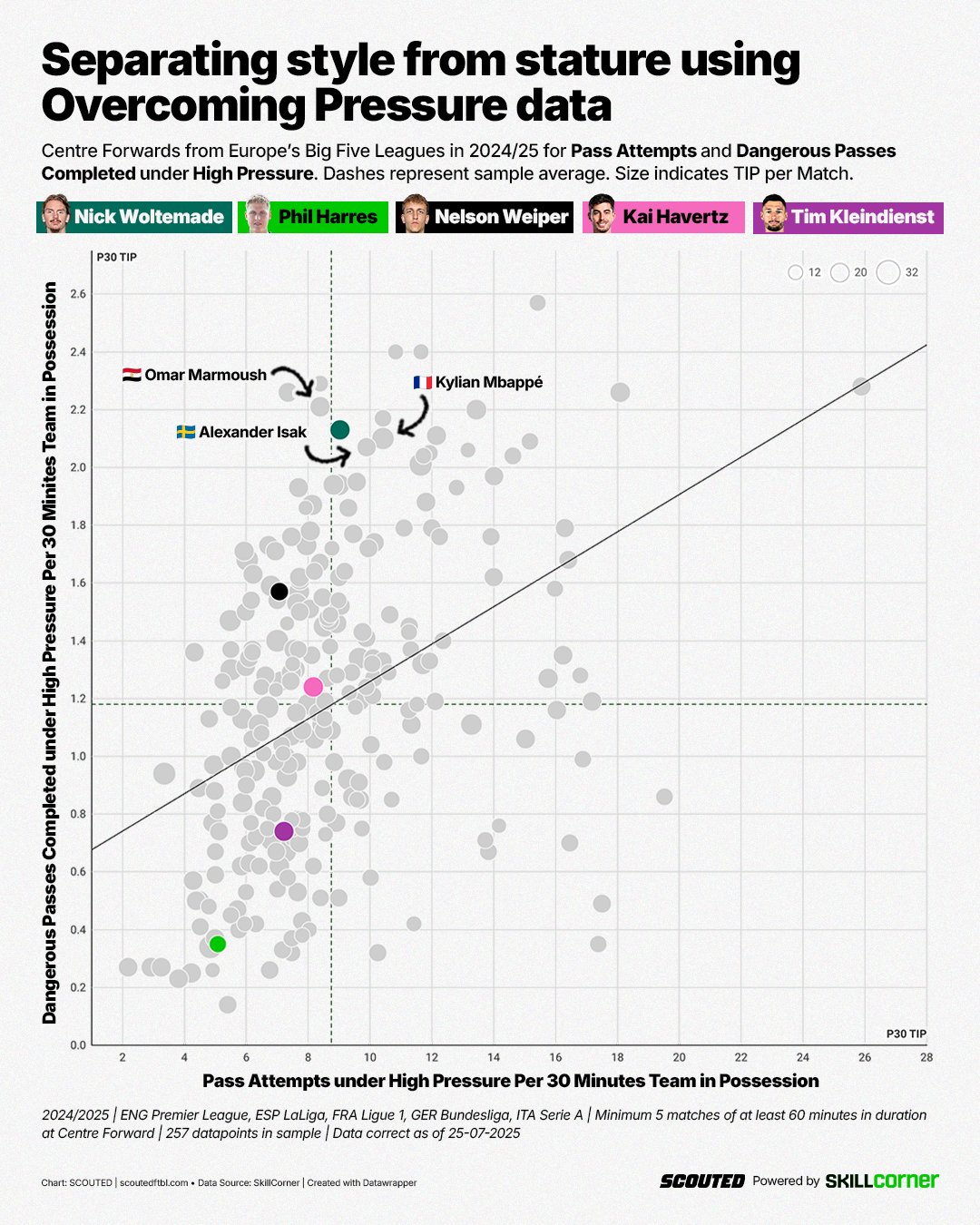
Looking at Passing through the lens of Passes for Runs will help round off these profiles.
As you might expect given the fact the Centre Forward Position Group makes the most Runs, they have the fewest Opportunities to Pass to Runs per Match and therefore make the fewest Attempts.
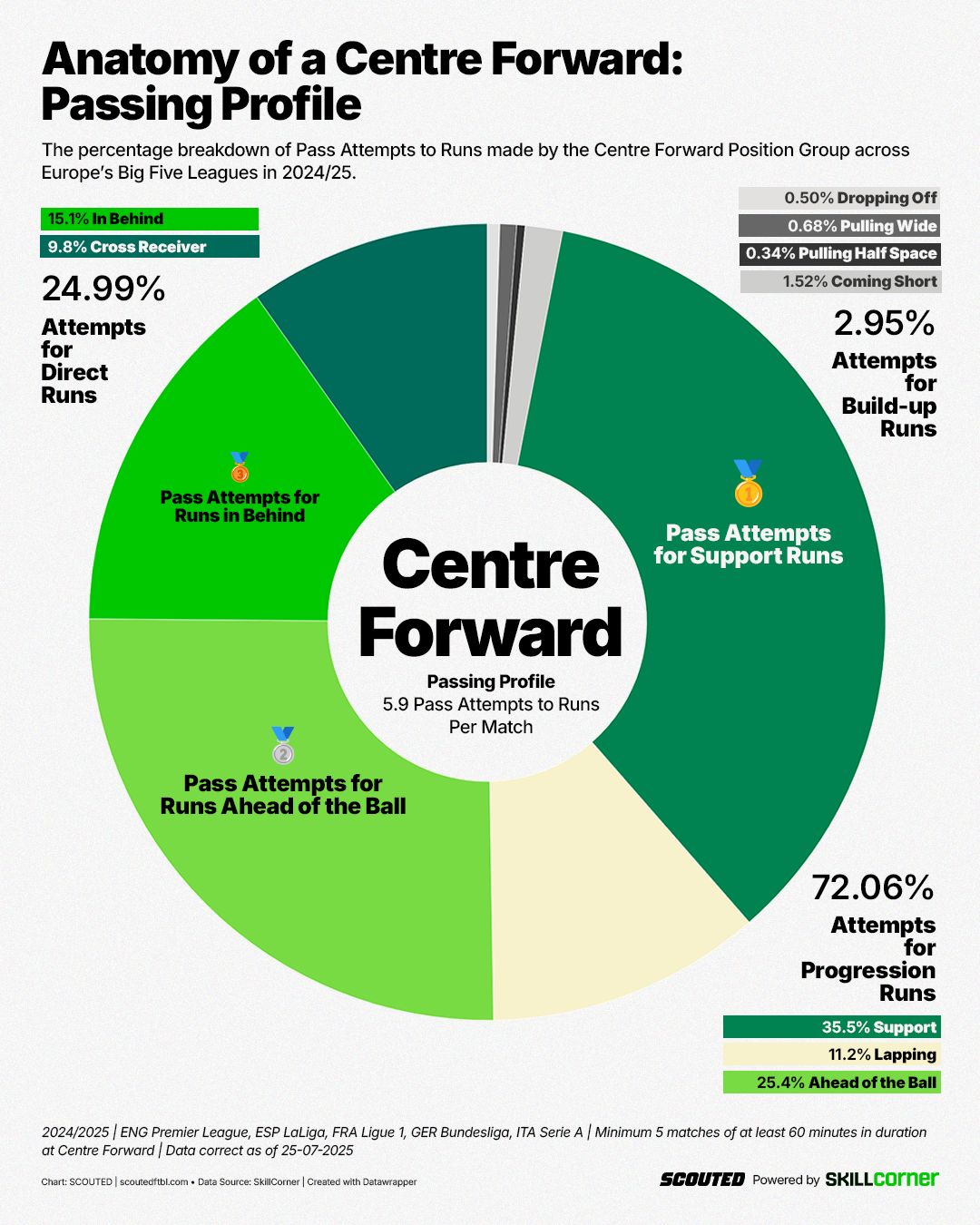
This means that Centre Forwards that attempt more Passes for Runs than average should arrest our attention immediately. Then we should look at the three most common Types: Support, Ahead of the Ball and In Behind.
Havertz, Kleindienst and Woltemade are the only BGFs that attempt more Passes to Runs than the 5.9 Centre Forward average. Woltemade, however, ranks highest with 8.42 Per Match just behind the 1.7m Julián Álvarez on 8.44. Again, size ≠ style.
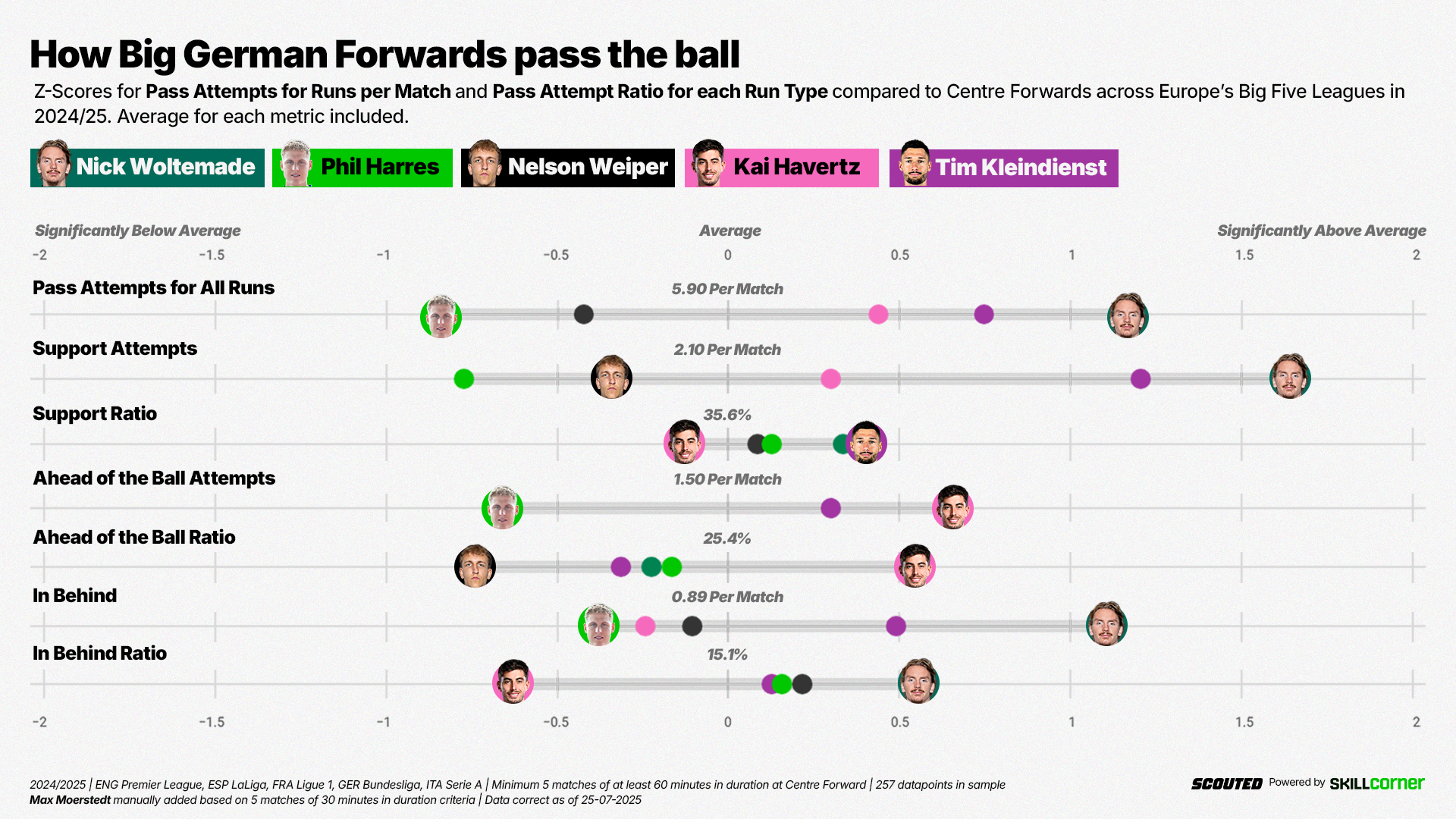
Similar to the Power Forward’s relationship with Runs In Behind, the fact that Kleindienst and Woltemade are outliers for the most common Pass Type, Attempts for Support Runs, is still of interest. Yes, the ratio of Pass Attempts for Support Runs is not notably above average, but Woltemade in particular attempts significantly more.
Given that Support Runs “originate behind the player in possession” and are played to runners “trying to engage in offensive play”, they may correlate with a back-to-goal style for Centre Forwards.
This plays into the Point Forward responsibilities of dropping and spinning, as well as Woltemade’s pressure-absorbent style. The fact that Woltemade also plays a notably above average number of Pass Attempts to Runs In Behind further illustrates the idea of pulling the game towards him before finding teammates escaping his orbit rather than moving himself. Kleindienst, as we saw earlier, is more willing to make the runs.
The combination of Support Runs, High Pressure Received - especially in the Central Channel - and Pass Attempts to Support and In Behind Runs begins to create the image of a Centre Forward with properties of a singularity. Woltemade’s gravitational pull makes him the Jupiter of Big German Forwards. A Gravitar.
Teams searching for a massive number nine that uses his jumbo frame to suck the ball, opponents and his teammates into his orbit could build their search around Woltemade’s profile.
How to pick a Big (German) Forward?
Of course, clubs are not restricted to one particular nationality when signing players. But national team coaches are.
Die Mannschaft might not have the largest pool of strikers in terms of quality, but they are leading the way in a literal sense. Every striker in this article would enable Nagelsmann to adhere to the massive number nine meta, but which one he chooses will depend on Germany’s approach and the players that surround them.
With injuries to both Havertz and Kleindienst, Woltemade started both World Cup qualifiers during the September 2025 international break. In the shock 2-0 defeat to Slovakia, he was supported by Florian Wirtz, Serge Gnabry and Leon Goretzka in a 4-2-3-1 formation.
In the 3-1 win against Northern Ireland, former Stuttgart teammate Jamie Leweling replaced Goretzka and Germany switched to a 3-4-2-1 system. In both games, Germany looked to use Woltemade's jumbo frame to absorb pressure and disrupt the defensive line by pulling them out of shape.
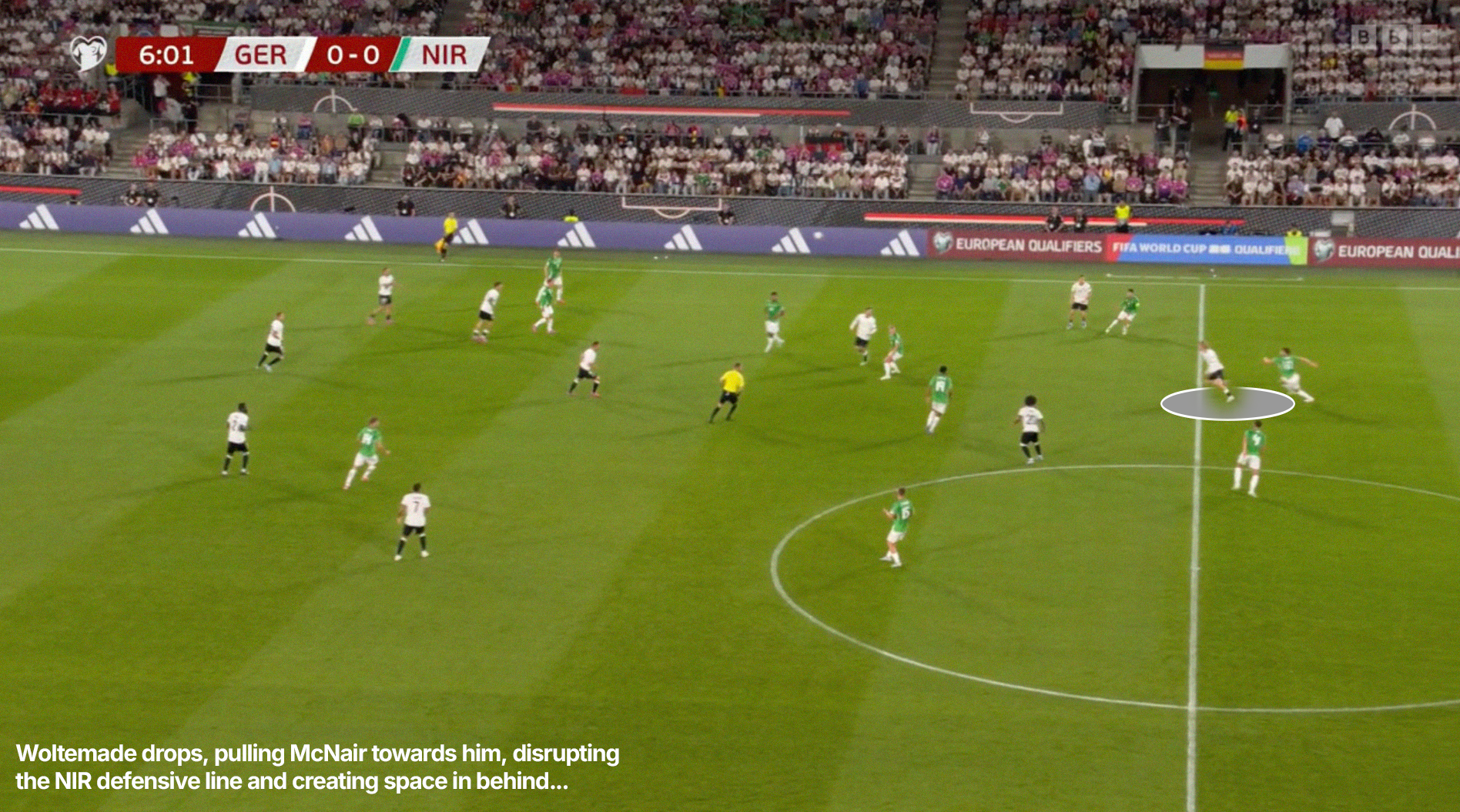
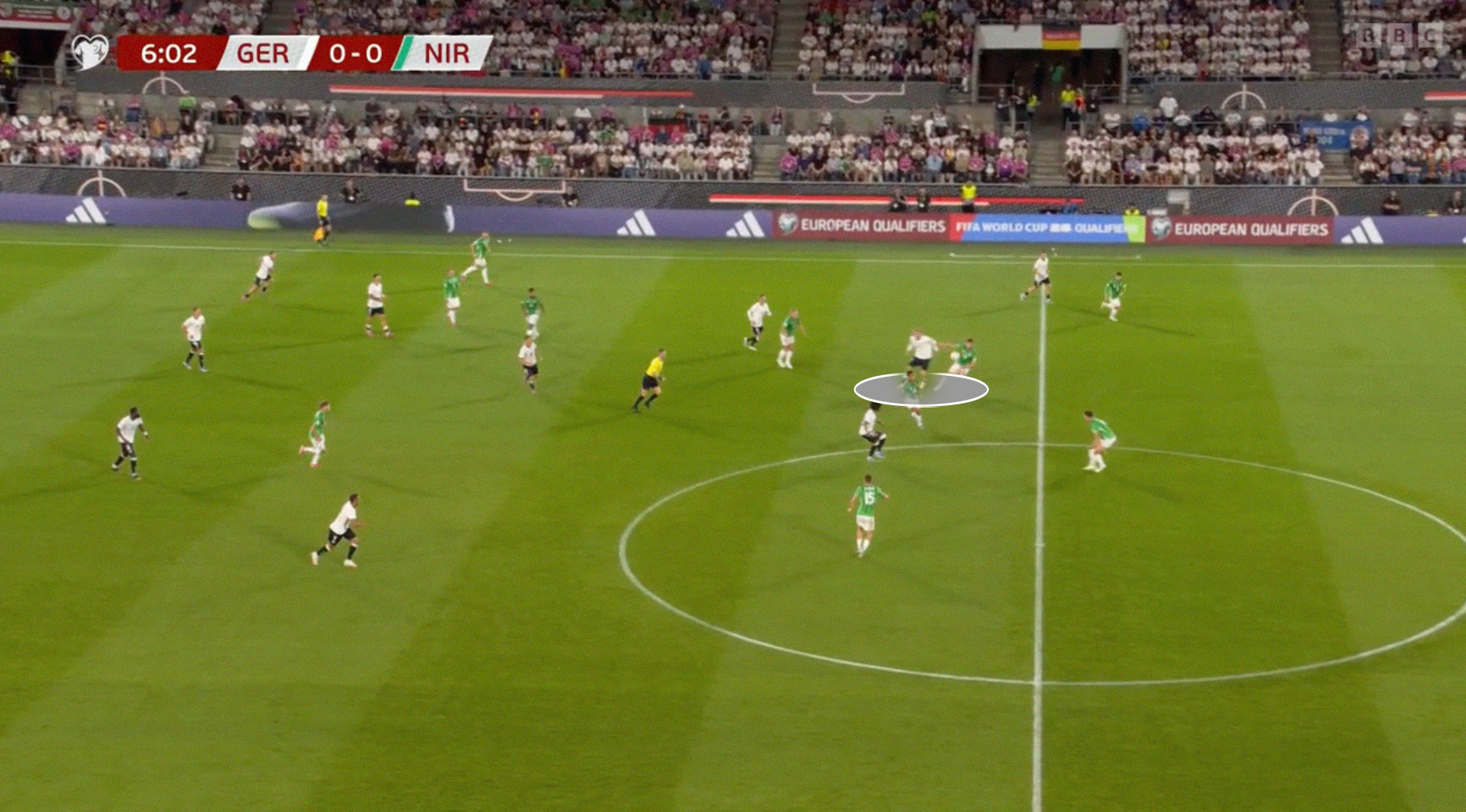
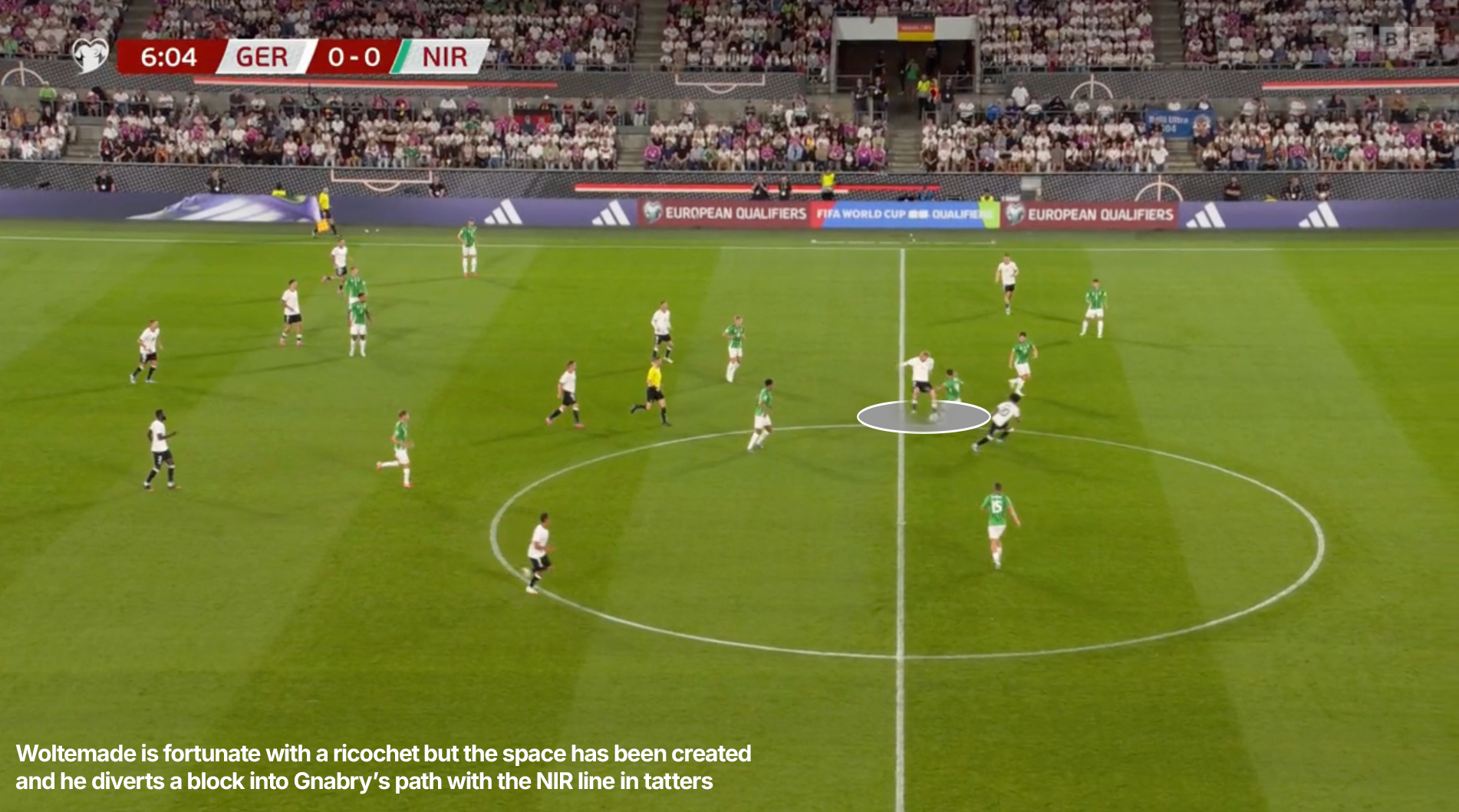
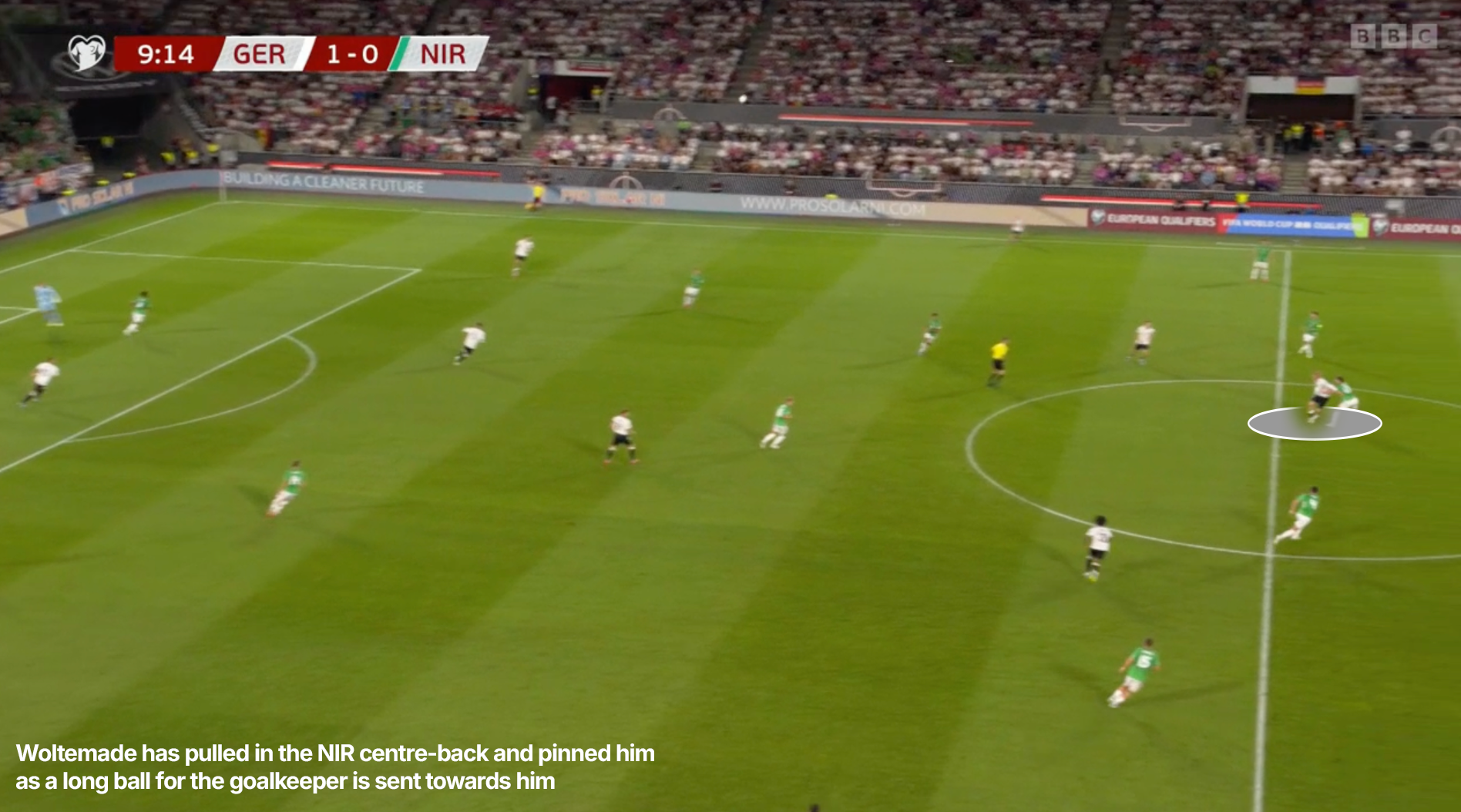


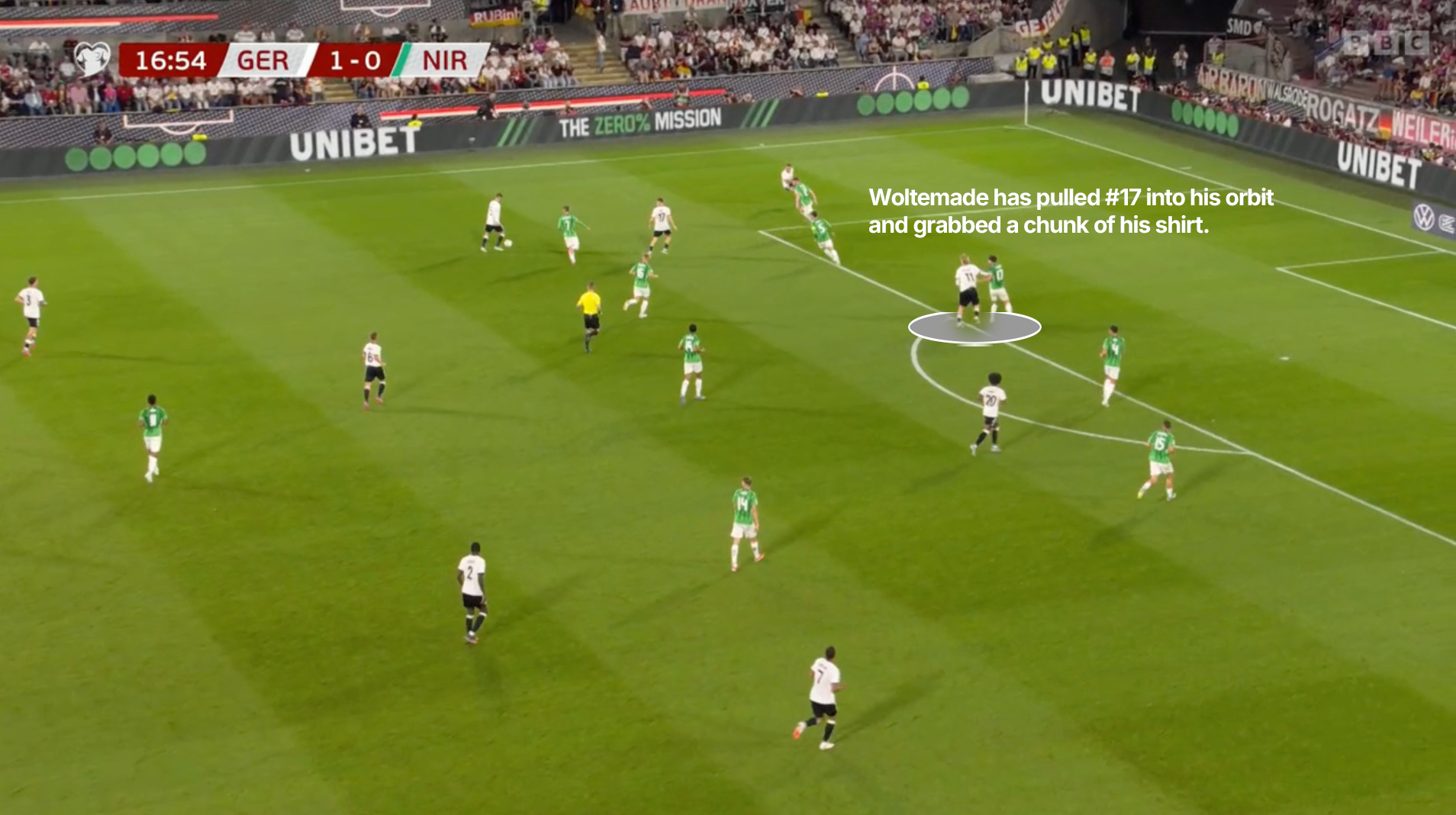
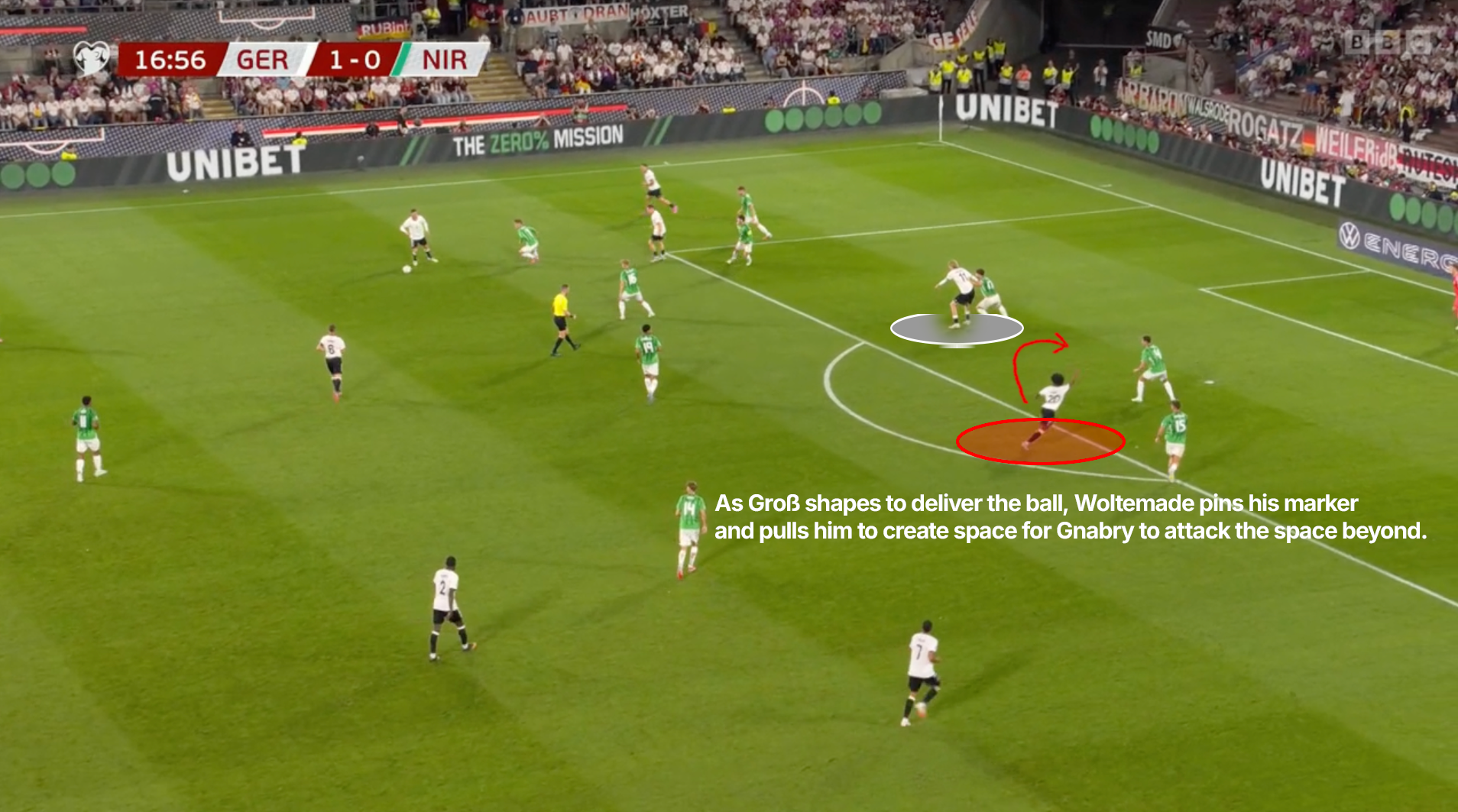
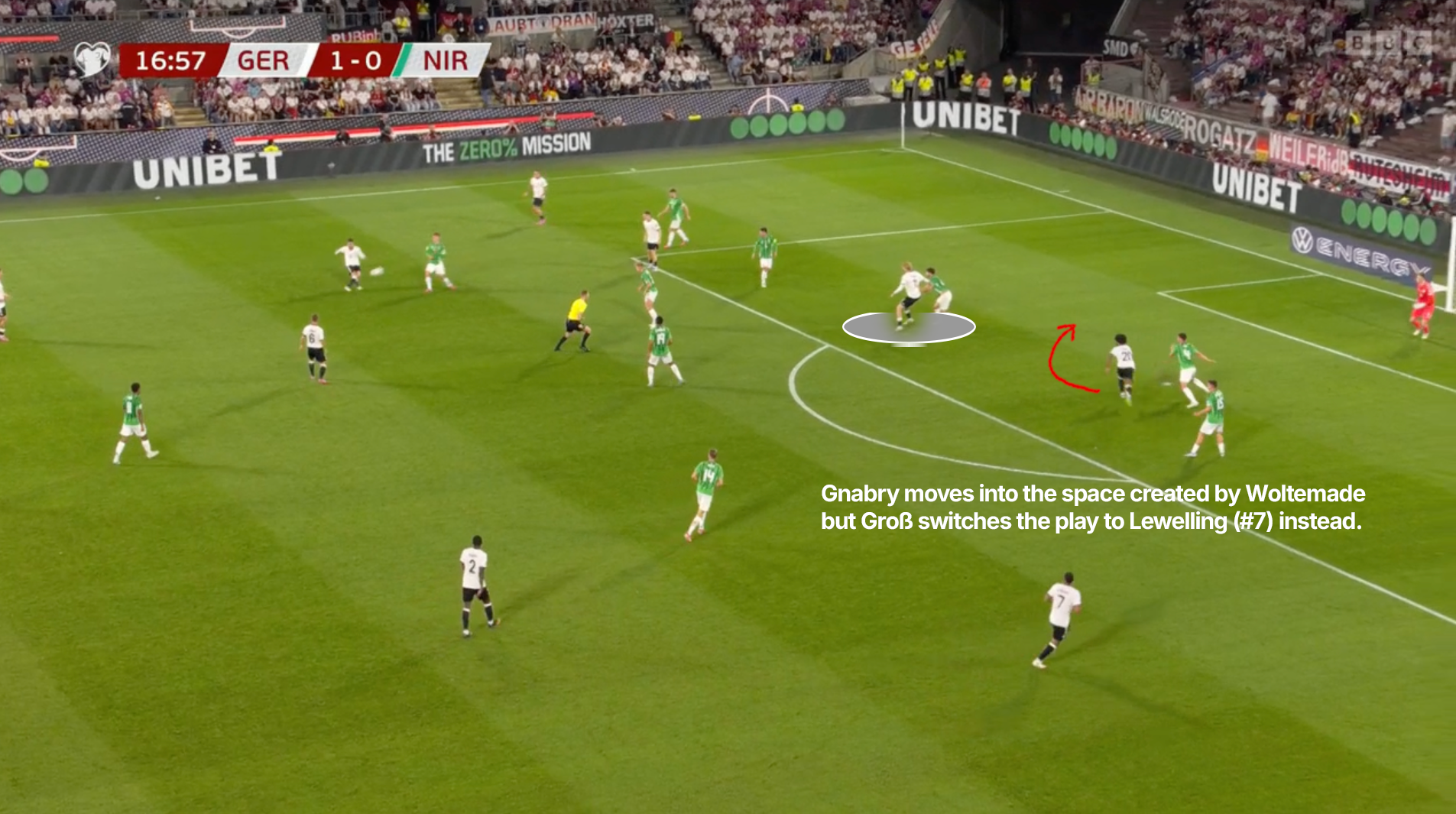
In the future, although extremely unlikely, If Nagelsmann is looking for a wildcard that provides a different dimension in case of emergencies or to counter a specific set-up, Harres’s jumbo Power Forward profile is an option.
However, Kleindienst the Point Forward offers the middle ground between the extremes of Harres and Woltemade. Although not blessed with searing speed, his jumbo frame creates space in the final third by running hard towards the box, and while he’s not uber-reliable under pressure, he is proactive in offloading to teammates before attacking the space he has vacated himself.
The expanded World Cup is likely to produce even greater gaps in quality and increase the variance in opposition tactics. This makes Kai Havertz a guaranteed member of the squad.
Often closest to the average for both style and substance across all suites of Game Intelligence Data, he could be described as a Chameleon - a player that is equipped with the physical, technical and mental tools required to shapeshift between Archetypes at will depending on environment, teammates and opponent. This also makes pairing him with at least one specialist vital - whether that be a Runner, a Passer or a Pressure sponge.
If paired with Woltemade, Havertz can scale up his Off-ball Running. If dovetailing with Kleindienst, Havertz can provide the supportive role. Even alongside Harres, Havertz would be able to absorb pressure allowing others to release his partner in behind before making a dart into the box himself.
For clubs that have to spend money on assembling their squads and are not restricted by a national pool, Archetypes are even more important. You might want, even need, a giant centre forward. But a specific set of skills or a certain style of play is not predetermined based on height.
Using the tip of the iceberg that is SkillCorner data, we have shown that despite the hegemony of massive number nines, there are multiple ways to measure them.
This newsletter was produced under a commercial collaboration with SkillCorner, SCOUTED’s official data partners. Their tracking and performance data is used by more than 150 of the world’s biggest clubs, leagues and confederations.



